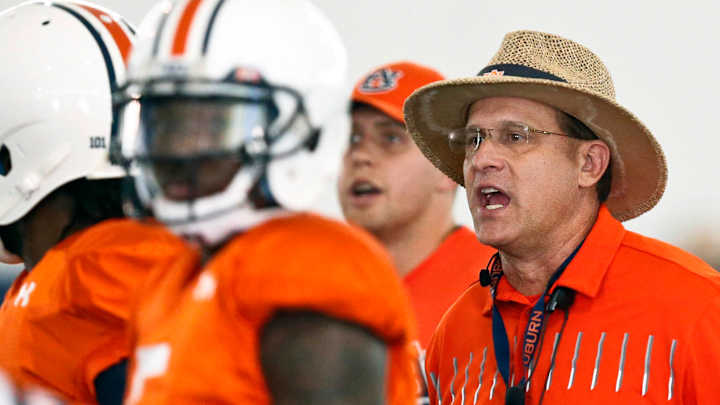Recent history shows QBs vulnerable to early season injuries

Some of the biggest losses in college football's opening week likely won't be reflected on the scoreboard.
Several teams in recent seasons have lost starting quarterbacks the first couple of weeks and spent the remainder of the year dealing with QB issues.
Air Force, Boston College, BYU, Kansas State, Notre Dame and Syracuse all lost quarterbacks to season-ending injuries by mid-September last year. Ohio State won the 2014 national title despite losing its top two quarterbacks to injuries.
''They're the only position that takes punishment without being able to give it back, and (they're) being in exposed positions,'' Florida State coach Jimbo Fisher said. ''I'm telling you, if you're not tough, you can't play quarterback.''
But since being tough can't always keep a quarterback on the field, the emphasis to have depth at the most important position on the team seems to have increased with the recent rash of early season injuries.
An AP analysis of all the Football Bowl Subdivision programs shows that only about 38 percent started the same quarterback in every game last season, whether due to injuries or performance.
Florida State uses GPS technology to measure athletes' performance and monitor their health. Fisher said the data revealed quarterbacks had the third-highest workloads on the team ''with the torque on their body with their legs, feet and all that stuff.'' The only position groups with higher workloads were receivers and offensive linemen.
It all adds up to teams taking steps to get backup quarterbacks more prepared.
Tennessee offensive coordinator Mike DeBord said the Volunteers' reserve quarterbacks get more reps in training camp now than he remembers backups receiving at his previous stops. DeBord also said backup college quarterbacks generally get more reps than backups in the NFL, where he was an assistant from 2008-12.
''We talk about what if (starting quarterback) Josh (Dobbs) gets injured or whatever,'' DeBord said. ''What are we going to do with the No. 2 guy? What kind of passing game are we going to have? What kind of running game are we going to have? All of that stuff, we talk about that all the time.''
They are common questions with quarterbacks being asked to do even more than they have in the past.
In 2014, 43 FBS quarterbacks had a combined 500 pass attempts and rushes and 34 pulled off the 500 double-double last season, according to cfbstats.com. Only 19 quarterbacks had a combined 500 passes and runs in 2009.
''I don't think you can ever have enough quality depth at the quarterback position if you run your quarterback,'' Auburn coach Gus Malzahn said.
Still, not all coaches believe that having a mobile quarterback makes him more susceptible to injury.
Nebraska's Mike Riley notes that Cornhuskers quarterback Tommy Armstrong's athleticism can allow him to avoid the type of direct hit that could have knocked out the pocket passers of previous eras.
But it isn't just the increased carries that could put quarterbacks at risk. With more hurry-up offenses, increased snaps also are a concern.
FBS teams have averaged at least 71.5 offensive plays per game each of the last four seasons. That average was as low as 64 in 2006 and reached the 70s just once from 2006-11. The fastest-paced offenses occasionally have snap totals reaching the high 90s or even 100.
''I'm not a scientist and I don't know what the analytics say of that number'' of more injuries, said Mississippi State quarterbacks coach Brian Johnson, the QB of the 2008 Utah team that went unbeaten. ''So I really don't have an educated answer on what the data would say.
''Some offenses have changed (since I played) and some offenses run 100 plays a game. I would think, and the mathematician in me says the more plays you run, obviously, the more likely you are to have a chance to get injured.''
Having a quality backup quarterback can make or break a season.
Michigan State advanced last year to the College Football Playoff in part because backup quarterback Tyler O'Connor helped the Spartans pull a 17-14 upset of Ohio State when a shoulder injury prevented Connor Cook from playing. Notre Dame lost starting quarterback Malik Zaire to a broken ankle in the second week of the season, yet DeShone Kizer stepped in and kept the Fighting Irish in playoff contention all year.
Ohio State's 2014 national championship provided perhaps the biggest statement on the importance of having multiple quarterbacks ready to play.
Braxton Miller, the two-time Big Ten offensive player of the year, injured his throwing shoulder in August and didn't play all year. J.T. Barrett replaced Miller and performed brilliantly before breaking his right ankle in late November. Cardale Jones started Ohio State's final three games and led the Buckeyes to a national title.
''All of those guys at Ohio State were similar enough that they didn't have to depart from what they did offensively,'' said Houston offensive coordinator Major Applewhite, a former Texas quarterback. ''I think that's important when you're building your quarterback room.
''You need to have an identity on what you want to be as a team offensively and defensively - and build that quarterback position around it so you don't have to switch offenses.''
Whatever the strategy, the successful teams seem to have a solid backup quarterback ready to play.
-------
AP Sports Writers John Kekis, Joedy McCreary, Eric Olson, Joe Reedy, Mitch Stacy and John Zenor and AP freelance writer Paul Jones contributed to this report.
-------
AP college football website: www.collegefootball.ap.org
